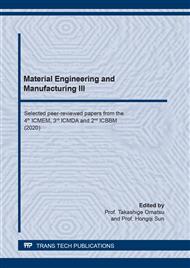[1]
R. A. Feely et al., Impact of Anthropogenic CO 2 on the CaCO 3 System in the Oceans,, vol. 305, no. July, p.362–366, (2004).
Google Scholar
[2]
T. Drzymała, W. Jackiewicz-Rek, M. Tomaszewski, A. Kuś, J. Gałaj, and R. Šukys, Effects of High Temperature on the Properties of High Performance Concrete (HPC),, Procedia Eng., vol. 172, p.256–263, (2017).
DOI: 10.1016/j.proeng.2017.02.108
Google Scholar
[3]
Chanakorn w., Phakphong N., Krisda S.(2561). The effect of heat on bond strength between concrete and reinforcing steel, Engineering ,Department of Civil Engineering, Faculty of Engineering, KasetsartUniversity.
Google Scholar
[4]
H. Yan, V. Kodur, S. Liang, L. Cao, and B. Wu, Development of metakaolin – fly ash based geopolymers for fire resistance applications,, vol. 55, p.38–45, (2014).
DOI: 10.1016/j.conbuildmat.2014.01.040
Google Scholar
[5]
S. K. Saxena, M. Kumar, and N. B. Singh, ScienceDirect Fire Resistant Properties of Alumino Silicate Geopolymer cement Mortars,, Mater. Today Proc., vol. 4, no. 4, p.5605–5612, (2017).
DOI: 10.1016/j.matpr.2017.06.018
Google Scholar
[6]
A. A. Ramezanianpour, R. Mousavi, M. Kalhori, J. Sobhani, and M. Najimi, Micro and macro level properties of natural zeolite contained concretes,, Constr. Build. Mater., vol. 101, p.347–358, (2015).
DOI: 10.1016/j.conbuildmat.2015.10.101
Google Scholar
[7]
S. Akbar, K. Dad, T.H. Shah, R. Shahnaz, Thermal studies of NaX zeolite with different degrees of cadmium exchange. J. Chem. Soc. Pak. 27, 456–461 (2005).
Google Scholar
[8]
F. U. A. Shaikh and V. Vimonsatit, Compressive strength of fly-ash-based geopolymer concrete at elevated temperatures,, (2014).
DOI: 10.1002/fam.2240
Google Scholar
[9]
T. W. Cheng and J. P. Chiu, Fire-resistant geopolymer produced by granulated blast furnace slag,, vol. 16, p.205–210, (2003).
DOI: 10.1016/s0892-6875(03)00008-6
Google Scholar
[10]
Prinya Chindaprasirt, 2017, Eco-efficient cement and concrete composite, Sustainable Infrastructure Research and development Center (SIRDC).
Google Scholar
[11]
P. Duan, C. Yan, and W. Zhou, Compressive strength and microstructure of fl y ash based geopolymer blended with silica fume under thermal cycle,, Cem. Concr. Compos., vol. 78, p.108–119, (2017).
DOI: 10.1016/j.cemconcomp.2017.01.009
Google Scholar


